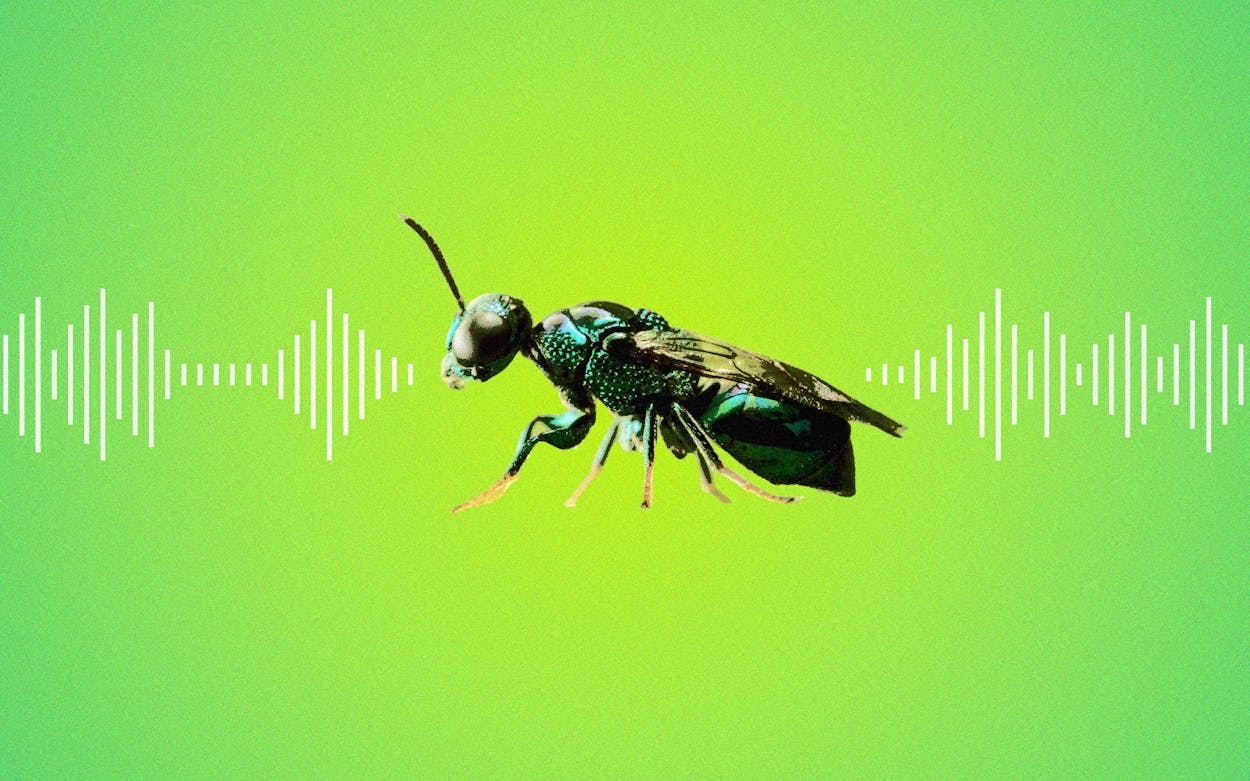Bird-watching—and, necessarily, listening—has exploded in popularity in recent years. But put your ears a little closer to the ground, and you might hear a quieter but just as potent kind of song coming from a little further down the food chain. That is, if you don’t squash the singer first. Yes, bugs make complex and fascinating sounds, and they’re not just coming from the cicadas and crickets that keep you up on hot summer nights. Take the leafcutter ant, which is active in Texas in the winter. “You can pick one up and hear it squeak,” says University of Texas entomologist Alex Wild. “There are all sorts of insects singing to each other for the same reason that birds are doing it. If you just pay attention, you can hear their little courtship songs.”
Alternatively, you could listen to Insectum, the latest release from Austin-based nonprofit Golden Hornet. The quirky “composer laboratory” was founded to foster community around classical music, hosting new music events like the bracket-style String Quartet Smackdown and commissioning outside-the-box projects like Pancho Villa From a Safe Distance, a bilingual “cross-border opera” about the Mexican general. Insectum is a nine-track avant-garde ode to insects ranging from flies to mosquitos to ants, spearheaded by composer and producer Graham Reynolds and intended not just to put the creatures we often view as pests in a different light, but also to encourage listeners to learn more about how their biodiversity is being threatened by climate change.

Insects make up the bulk of all life on earth, both by weight and by number of species: A staggering 80 percent of all animal species are insects. But bugs are also in peril, with 40 percent of all insect species in decline and a third at risk of extinction. Entomologists struggle to get the public to care about this, since creepy-crawlies lack the charisma and cuteness of, say, polar bears or tigers. Perhaps, in its own small way, an album of insect-inflected music could help change that. “Insects are critical to the global ecosystem in a way that humans are not at all,” says Reynolds, who is a cofounder of Golden Hornet. “It’s a little humbling.” He will be joined by his collaborators, cellist Jeffrey Zeigler and percussionist Susie Ibarra, to premiere the album’s compositions on February 22 at the Draylen Mason Music Studio in Austin.
Reynolds’s initial inspiration for the project came from the work of the influential seventeenth-century scientific illustrator and entomologist Maria Sibylla Merian, who drew and described the life cycles of insects at a time when many believed they simply appeared fully formed from the earth. As he did more research, the composer—whose work has been most widely heard in the soundtracks of many of Richard Linklater‘s films—came across Alex Wild’s entomology class at the University of Texas at Austin. Reynolds got in touch with Wild, and spent a semester auditing his class. “I learned that there are more insects that have never been identified than there are that have been identified,” he says. “It’s just an infinite world of fascinating things.”
Going back to school radically shifted Reynolds’s perspective, whether he was learning about the existence of a new kind of ant recently discovered on the UT campus (rodeo ants, so named not just for their Texan bona fides but for the way they cling to other animals, like tiny bullriders) or Melolonthinae larvae—a.k.a. the grub worms that might be attacking your garden—which earned a track on the album.
“I already had giant folders of sound effects that included folders of insect sounds, and they’re what you would expect: mosquitoes, flies, bees—things like that,” says Reynolds, who has done extensive work in film and TV sound. “We did make music with that, but the breadth of the palette was just so much bigger. Some of it required imagining what these sounds might be like, because they can be inaudible to humans. But even just with the insect sounds you can hear, it was a much wider world than I expected.”
Much of the project came together during the pandemic lockdown, when Reynolds started sending ideas to his collaborators, including Zeigler (with whom he had previously worked on The Sound of Science collection) and Ibarra. Each is renowned within their respective worlds, Zeigler as a former member of the Kronos Quartet as well as a soloist, and Ibarra as a composer, improviser, and interdisciplinary sound artist.
All three members of the trio began composing from the initial arthropod inspiration, digitally layering sounds atop each other’s pieces from afar. Sometimes they interpreted the insects’ actual sounds—it’s not hard to understand the droning synth sounds and static in “Desert Locusts Plagues,” for example—while sometimes the musicians took a broader scope. “Giant Snail Devours Earthworm” began as Reynolds’s score to a YouTube video that showed exactly that, drawing from the gruesome action rather than specific noises. The end result is a mix of composition, improvisation and sound design—a holistic aural experience that mimics and amplifies the all-encompassing impact insects have on the sounds we hear every time we go outside (or sometimes, frustratingly, stay inside).
“When you’re sitting outside and you close your eyes and you listen, you can tell where you are and what season it is because the ambient noise shifts at different times of the year and in different parts of the country,” says Wild. “Most people may not quite register why, but a lot of that has to do with the crickets and cicadas and other insects that make up that background.”
To make sure he wasn’t misrepresenting his chosen subjects, Reynolds sent all the tracks to Wild and another UT entomologist, Jo-anne Holley, before they were finalized for feedback. One that required tweaking was “Army Ants,” which began (understandably) as a regimented, almost militant piece—but Wild and Holley pointed out that even army ants embrace the chaos sometimes. “They advance as this swarm where they’re moving back and forth and just scaring everything up,” as Wild puts it. So the composers added a new, appropriately unpredictable intro.
The album is a scientifically informed work of abstraction, blending actual insect sounds with imagined and mimicked insect sounds with looser, harder-to-pin-down musical ideas—all intended to get us to listen a little more closely. “There are certain bug stories that pop culture tells over and over again: the caterpillar turning into the butterfly, those sorts of things,” says Wild. “What I love about Insectum is that it’s kind of noncanonical insects—and instead of telling the standard story about them, it drops you into their world. It decenters the human experience, and gives people a chance to empathize with these other creatures around us.”






